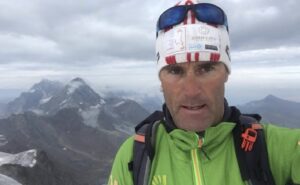SpO2 monitors, live ECG readouts, hypoxic tents: Just how technical can an Everest climb get before it becomes not climbing but something else?
The number of foreign climbers bound for Everest continues to climb daily — 196 with permits, as of today. Those hoping for an “olden times” Everest, with only some colorful dots scattered up the mountain on summit day, will be disappointed. If a narrow, perfect summit window opens, as it did in 2019, the shameful image of long lines and the morbid reports of climbers dropping dead in their tracks might repeat.
Some say that the risk of death is a voluntary part of the game, but for professional expedition operators, it is not: Safety is one of the main reasons that clients hire them. This is why the latest gadgets are usually tested, even developed, on the big guided expeditions.
After a preliminary test in 2019 on Everest’s North Side, plus further R&D in the Alps last year, Lukas Furtenbach is heading for Everest with two teams and a little wonder in their…gloves.

New oxygen systems allow an increased flow of up to eight litres.
All climbers attempting the summit will have a sensor monitoring the oxygen saturation (SpO2) in their blood. Oximeters are already common in Base Camp or higher camps, but not while the climber is moving, especially on summit day.
Furtenbach has decided to change that and to try to answer the most difficult summit-day question of all: If, or when, a climber should turn around. Until now, the decision has been the climbers’, or in serviced teams, the guide’s.
Climbers on O2 usually turn the flow on their oxygen systems from two to four litres a minute from 8,700m to the summit. They are supposed to turn it back down to two litres during their descent.
However, the need for supplementary O2 is very personal and varies according to an individual climber’s physical condition, fitness level, breathing rate, acclimatization, hydration level, genetic gifts, etc. This is why it is so hard to set a standard flow rate for every team member.
“The idea is to know the client’s SpO2 level at every moment and make sure that it does not go below a critical value,” Furtenbach explained to ExplorersWeb. “That way, we can make sure that the climber is not developing altitude-related problems.”
Furtenbach notes that this likely means that his expeditions will need much more O2 on the upper slopes because they’ll discover that clients need higher flow rates to keep their SpO2 levels in control.
“On the other hand,” says Furtenbach, “they may need less O2 below 7,500m. In the end, it could be the same total amount of O2, just differently distributed.”

Portable SpO2 sensor. This 2019 model has been improved for 2021 expeditions.
The sensor is integrated into the climber’s liner glove and connects to a smartphone that sends the data in real time via satellite to anyone, anywhere — including the expedition doctor in Base camp, who is prepared to climb at least partway to the client if needed.
The SpO2 sensor works well, and the information is reliably conveyed, but it is still not enough. A low reading is concerning, but it is difficult to say when low is too low, or whether it is the only factor that may make a person collapse and die.
“Many people who die at altitude don’t actually perish of HAPE or HACE,” says Furtenbach. “They may suffer a stroke or cardiac problems.”
After weeks at altitude, the blood becomes thicker from the extra red blood cells built up during acclimatization. That increases the risk of stroke and heart events.
“You can’t forecast this with only SpO2 levels, so we’ve attached to the climber’s chest a very small, waterproof ECG recorder, which also connects to the smartphone,” Furtenbach said. “This provides high-resolution ECG graphs, which can be monitored by a doctor anywhere and who can spot cardiac problems before they develop. We can then communicate with the guide and have him turn the climber around.”

An ECG monitors the climbers’ vitals from BC.
The climber who has paid a lot of money to summit may not take this decision well, but at least it’s based on data. It’s no one’s gut call.
Furtenbach’s team has never had an accident and holds a 100 percent success rate on Everest. The main reason is that they accept only clients who are fit enough, technically prepared, and willing to follow the company’s instructions and accept a guide’s decision to turn them around. “The number of people we refuse on our Everest expeditions is far greater than the number we accept,” Furtenbach said in an earlier interview.
Nor do they limit their clients’ oxygen use. Why should it matter if they use two litres per minute or six litres per minute? — both are oxygen-aided climbs. Their SummitOxygen systems can supply up to eight litres a minute.

Furtenbach’s method has its critics. Hard-core climbers like Reinhold Messner insist that so much technology kills the adventure and turn climbing expeditions into something else. “Our climbers are not professionals,” says Furtenbach. “They are clients who pay us to make responsible decisions about their safety.”
There are other questions, such as how to proceed in case of equipment failure. It may also promote a misleading sense of safety that ignores the mountain’s other objective dangers. Either way, the technology is here to stay.






